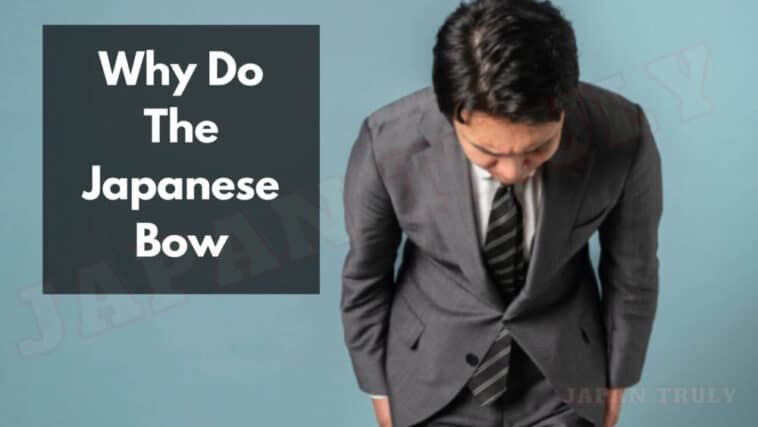Ever wondered why the Japanese bow? Here’s everything you need about the reasons behind why the Japanese bow to greet others.
The Japanese bow, a gesture deeply woven into the social fabric of Japan, is a nuanced form of communication expressing respect, gratitude, apology, and greeting.
More than a mere custom, it embodies the cultural emphasis on harmony, etiquette, and humility that is central to Japanese interpersonal relationships.
Page Contents
Why The Japanese Bow?
As we’ve said there are several reasons and instances why the Japanese people bow so here we will analyze the types of occasions Japanese people are obligated to bow.

Initially, bowing or Ojigi is a method of a traditional Japanese greeting when meeting someone for the first time and in fact, Japanese people even bow to greet their family members as well.
But bowing down is not only limited to saying hello to your fellow visitors but to other occasions as well such as:
Japanese Bow When Entering or Leaving a Classroom or a Business Meeting
It’s a common practice for Japanese people to bow when they’re at school or at work. Japanese children are taught from a young age to greet their teachers and colleagues by bowing down. Bowing is usually performed when the start of a classroom or a business meeting and also at the end of the session.
- Related: How Do Japanese Show Respect?
Japanese Bow As A Sign of Respect
Most Japanese people are conservative hence they show respect to elders or any important person by bowing down to them. You can mostly see chauffeurs or hotel staff bowing down to customers and visitors as a means of greeting them and showing respect.
Japanese Bow Also To Show Gratitude to Someone
Don’t be confused when a Japanese person bows down to you after you’ve helped them because bowing is also a way of thanking someone in the Japanese culture.
Japanese Also Bow When Expressing Remorse or Conveying Condolences
Bowing down is not only a practice for happy occasions but for grieving occasions as well. Japanese bow when they want to apologize or show their condolences to someone.
Japanese Also Bow When Requesting for Help
The Japanese people also try to be respectful by bowing when asking for help from someone.
Japanese Bow When Wishing Luck and Congratulating Someone
Unlike the West where people congratulate someone verbally, the Japanese are accustomed to bowing when wishing someone the best and congratulating them for their achievements.
Japanese Bow During An Act of Worship
Bowing is also a spiritual practice in Japan where it’s common to see people bowing down in temples and to the monks as well.
Japanese Also Bow Before And After Martial Arts Practicing
Since Japan is a country that loves martial arts, the act of bowing is also carried out before and after performing martial arts.
Different Types of Bows The Japanese Practice
We know that the Japanese people bow for multiple reasons and it’s worth knowing that there are different types of bows performed by the Japanese people for different occasions. The types of bows also differ from person to person where a person of a low status has to perform a distinct bow from someone who’s of high status.
The different types of Japanese bows are:
- Keirei
This is one of the common types of bow used when greeting teachers, bosses, or anyone in a superior position. This bow is performed by slightly bending your torso at about 30 degrees and immediately lifting up. Make sure to keep your eyes looking down.
- Eshaku
This is a casual bow that’s performed when meeting a friend or a stranger just to show respect. Eshaku is performed by doing a minimal bow that is at least 15 degrees.
- Saikeirei
Saikeirei is a bowing position that’s performed by bending your torso for 45 degrees. This type of bow is usually performed when you’re apologizing to someone or asking for their favor and also when greeting someone who’s very important. When doing the saikeirei bow you’re required to stay in the bowing position for a little while.
- Seiza
This is a seated bowing position in which you’re required to sit on your calves by keeping your feet flat on the floor. Your hands must be placed on your thighs with your palms facing down and you slightly bow. Seiza is performed mostly during formal occasions.
- Zarei
Zarei is another seated bowing position that’s performed in a simple sitting position. This bowing is frequently performed during traditional Japanese occasions like tea time, functions, martial arts, etc.
- Senrei
This is a casual seated bowing position that’s performed for informal occasions. Senrei is performed by sitting on your calves and bending your torso for 30 degrees while your hands are placed on your knees.
- Futsurei
This is a traditional seated bowing position where you’re required to bend forward until your face is a few centimeters away from the floor.
- Dogeza
This is a dying bowing position that requires the person to place the hands, knees, and face on the floor as well. Dogeza is generally a bowing position that’s used when someone is too desperate or begging. It’s also a disrespectful bowing position and almost no one performs it.
How To Perform The Right Japanese Bow?
The Japanese are conservative people who are raised to be well mannered and they’re ingrained from childhood to behave well and perform any task perfectly. Hence, they take the action of bowing very cautiously and you do not want to mess up a bow when meeting a Japanese person, especially if they’re elderly to you.
The key step to follow when bowing is to ensure your limbs are intact. Your feet must be kept straight and an inch apart while your arms are kept straight on the sides with open fists.
However, this ruling of bowing differs for women as they’re required to keep their feet together when bowing and their hands must be placed on top of each other on their abdomen.
Another crucial step to bowing is to look down and not the person’s face while bowing because it’s considered to be rude and mannerless. When bowing down you can simply look at the ground or your feet and swiftly lift up your torso after bowing.
Since there are several types of bows, make sure to learn and perform the right bowing technique for the right occasion.
Do’s and Don’ts of Bowing in Japanese Culture
As a foreigner to Japanese culture, it’s excusable if you make slight mistakes while bowing for the first time.
However, it’s best to ensure that you don’t offend the Japanese culture or the person when attempting to bow. Therefore, there are certain things you should and should not do when bowing.
- Make sure you don’t have anything in your hands while bowing because you must keep your hands free when bowing. If you have your mobile phone keep it in your pocket or if it’s a briefcase or a bag place them down before bowing.
- If you see the other person bowing to you immediately bow to them because it’s considered impolite if you don’t bow back.
- Keep your gaze down when bowing.
- Don’t stare at the person after lifting up from the bowing position because it’s considered rude.
- Don’t bow too low because the other person would feel obliged to do so as well.
- Don’t bow too many times at once because it might seem awkward and to be mocking Japanese culture which can seriously offend a Japanese person.
- If you’re bowing in a compact area make sure to move to the left or right side of the person in front of you to avoid knocking your head with them. Bow slightly and lift your head up without knocking the other person.
- Keep your hands on the sides when bowing and not in your pockets and also your legs only a few widths apart and not too spread.
- If you see the other person giving you a handshake then avoid bowing to them.
How Did Bowing Become A Japanese Practice?
If the Japanese people place great emphasis on the bowing details and importance to the bowing culture then there must be a backstory why bowing is considered too significant in Japan.
It is believed that the bowing practice was established by the Japanese people when the spread of Buddhism began.
Buddhism prayers involve bowing down to Buddha statues and since then the bowing practice became a day-to-day practice as it was carried out when practicing martial arts and then on every other occasion as well.
Why The Japanese Bow: FAQs
Why do the Japanese always bow?
It’s a cultural practice in Japan to bow for several reasons and occasions. The Japanese people greet each other by simply bowing. Bowing is not only limited to a greeting in Japan but also for other reasons like showing respect to elders, saying thank you, apologizing, expressing condolences, and even when asking for someone’s help.
Why do Japanese people bow multiple times?
The Japanese people are taught to be respectful in every instance and occasion. The Japanese bow when they want to greet someone or to show gratitude for someone. It’s also common in Japan to bow when you want to say goodbye or to apologize as well.
Do Japanese bow to say thank you?
The usual norm of the Japanese people to show their gratitude to someone is by simply bowing and expressing verbal gratitude which is “Arigatou” in Japanese. It’s also common for some Japanese people to keep their palms together when bowing to say thank you.
Should tourists bow in Japan?
Generally, the Japanese don’t expect tourists to bow to them, however, to show respect to the natives it’s ideal to bow when greeting a Japanese person. You can bow after you see someone bowing to you which is done out of respect. Make sure you don’t bend too low or look at the other person in the eye while bowing.





